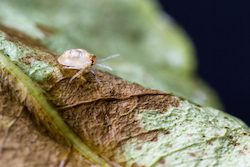New findings showing spider mites are susceptible to bacterial infection could benefit agriculture
Spider mites injure plants by piercing cells and sucking out their contents, causing damage to leaves which then lose photosynthetic surface as feeding continues. Water loss can get out of control and both photosynthetic rate and leaf water status decline with increasing levels of spider mite injury. Populations of mites are held in check by weather, host quality and natural predators. The last being far less effective during drought or very hot spells. Many of the extremely important predatory mite species responsible for keeping spider mite numbers below damaging levels do not function well in high temperatures. They will often leave the plant for leaf litter or other cooler and more protected areas, and become dormant. In addition to spider mites being well-adapted and quick to develop pesticide resistance, often within a growing season, pesticides worsen the problem by destroying the predatory mite populations, thus eliminating the natural controls on the spider mite species and allowing them even more opportunity to explode in population numbers. So the hunt is on for an alternative method of control A paper recently published by the Royal Society sets out research into the mites’ responses to bacteria. It was co-authored by a EU-funded researcher through Marie Sklodowska-Curie Actions (MSCA) Individual Fellowship, under the DOGMITE project. The team report that mites infected with Gram-positive and Gram-negative bacteria display high mortality when compared with controls (both mock-infected and infected with heat-killed bacteria). The spider mites did not trigger an induced immune response against bacterial infection. Adult T. urticae females, which include red spider mites and two-spotted spider mites, were infected with E. coli and B. megaterium by injection. RNA transcripts produced by the genome were analysed at 3, 6 or 12 h post-infection. Although individual transcriptomic comparisons between injected and non-injected mites revealed differential expression, the team found no consistent response to injection across all time points and treatments. This seems to indicate that wounding itself does not induce an immune response. Bacterial proliferation within the spider mites was maintained steadily across 4 days post-injection, which was reflected in their mortality profile. The team states this strongly indicates that no resistance or tolerance mechanisms are operating in the spider mite and that uncontrolled bacterial proliferation caused the observed mortality rates. They explain, ‘We show that defence systems within T. urticae are clearly insufficient in face of bacterial infections that are innocuous to Drosophila and other chelicerates such as ticks (…) which occupy a very different ecological niche, namely bird litter and other substrates prone to bacterial proliferation and infection.’ Why are spider mites vulnerable to bacteria? The aseptic nature of the spider mites’ feeding source is supported by the comparative characterisation of the gut bacteria present in the two mite species studied here that, researchers say, differs by several orders of magnitude. This ecological feature, which eliminates the need to constantly balance bacterial interactions, may relax the pressure to evolve or maintain a transcriptionally induced and regulated response. The authors point out that other studies looking into the immunity in arthropods’ comparable dietary regimes will provide clearer answers about the forces driving convergent degeneration of this type of immune response. Recent work has shown that, in addition to aphids, other phloem-sap feeders, such as white flies and psyllids, carry a reduced gut microbiota in both laboratory and natural populations. This means they too could be susceptible to bacterial infection, opening up horizons to effective control while reducing the amount of pesticides needed. The DOGMITE (The unique dioxygenases of phytophagous spider mites: new enzyme players in plant-herbivore interactions?) project aimed, amongst other objectives, to open up avenues to exciting biotechnological applications hopefully extending well beyond agriculture. Marie Sklodowska-Curie Actions – boosting EU research Today, 7 November 2017, is the 150th anniversary of Marie Sklodowska-Curie’s birth. Twenty years ago, the EU established the Marie Skłodowska-Curie Actions in her name and since then over 100 000 researchers have received support from the programme. It provides grants for all stages of researchers' careers - be they doctoral candidates or highly experienced researchers - and encourages transnational, intersectoral and interdisciplinary mobility. For more information, please see: CORDIS project website Marie Skłodowska-Curie Actions in a nutshell – video
Countries
Netherlands



